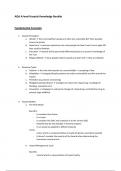Summary
Summary AQA A-level Hazards Knowledge Booklet
- Institution
- AQA
Detailed notes of all theories in the Hazards topic of AQA A-level geography, organised in order of the syllabus. All theory is also supported with examples and contextual information. The required case studies are; Volcanic Eruption - Eyjafjallajökull Iceland 2010 Earthquake - Nepal April 20...
[Show more]



